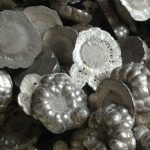Notice: Undefined index: sith_hide_share in /www/sites/alloy.wiki/index/wp-content/themes/likegoogle/single.php on line 32
Deprecated: get_settings is deprecated since version 2.1.0! Use get_option() instead. in /www/sites/alloy.wiki/index/wp-includes/functions.php on line 4862
The hardness of tungsten copper alloy ≥ 184.

Tungsten copper refers to an alloy composed of tungsten and copper. Commonly used alloys contain 10% to 50% copper. The alloy is prepared by powder metallurgy, which has good electrical and thermal conductivity, good high temperature strength and certain plasticity. At very high temperatures, such as above 3000°C, the copper in the alloy is liquefied and evaporated, absorbing a large amount of heat and reducing the surface temperature of the material. So this kind of material is also called metal sweating material.
Tungsten copper alloy has a wide range of uses, mainly used to manufacture high-temperature components such as the contacts of high-voltage electrical switches that are resistant to arc ablation, rocket nozzle throat linings, and tail rudders, as well as electrodes for electrical machining, high-temperature molds and other Applications requiring electrical and thermal conductivity and high temperature use.
Tungsten copper alloy is made of fine tungsten and copper powders, refined by first-class immersion sintering process, can withstand high temperature and high stress of nearly 2000 degrees, has high melting point, high hardness, anti-burning and good anti-adhesion, and electro-erodes the product surface High finish, high precision, low loss.
Features of tungsten copper alloy:
1. Resistance welding electrode: Combining the advantages of tungsten and copper, high temperature resistance, arc ablation resistance, high strength, high specific gravity, good electrical conductivity, good thermal conductivity, easy cutting and processing, and has the characteristics of sweating and cooling, due to the high temperature of tungsten The characteristics of hardness, high melting point and anti-adhesion are often used to make projection welding and butt welding electrodes with certain wear resistance and high temperature resistance.
2. Electric spark electrode: When the mold made of tungsten steel and high temperature resistant super hard alloy needs electrolytic corrosion, the ordinary electrode wears large and the speed is slow. The high electric corrosion rate of tungsten copper, low loss rate, precise electrode shape, and excellent processing performance can ensure that the accuracy of the workpiece is greatly improved.
3. Electrode of the high-voltage discharge tube: When the high-voltage vacuum discharge tube is working, the temperature of the contact material will rise by several thousand degrees Celsius within a few tenths of a second. The high ablation resistance, high toughness, and good electrical and thermal conductivity of tungsten copper provide the necessary conditions for the stable operation of the discharge tube.
4. Electronic packaging material: It has both the low expansion characteristics of tungsten and the high thermal conductivity of copper. Its thermal expansion coefficient and electrical and thermal conductivity can be changed by adjusting the composition of the material.
Guest contributors are welcome at the Alloy Wiki.It is a weekly wiki and guide on alloy information and processing technology, while also about the vast array of opportunities that are present in manufacturing. Our team of writers consists of a Machining Material Supplier / Machinist / Tool and Die Maker, a Biomedical Engineer / Product Development Engineer, a Job Development Coordinator / Adjunct Professor, and a President and CEO of a manufacturing facility.
Link to this article:What is the hardness of tungsten copper alloy?
Reprint Statement: If there are no special instructions, all articles on this site are original. Please indicate the source for reprinting:Alloy Wiki,thanks!^^


